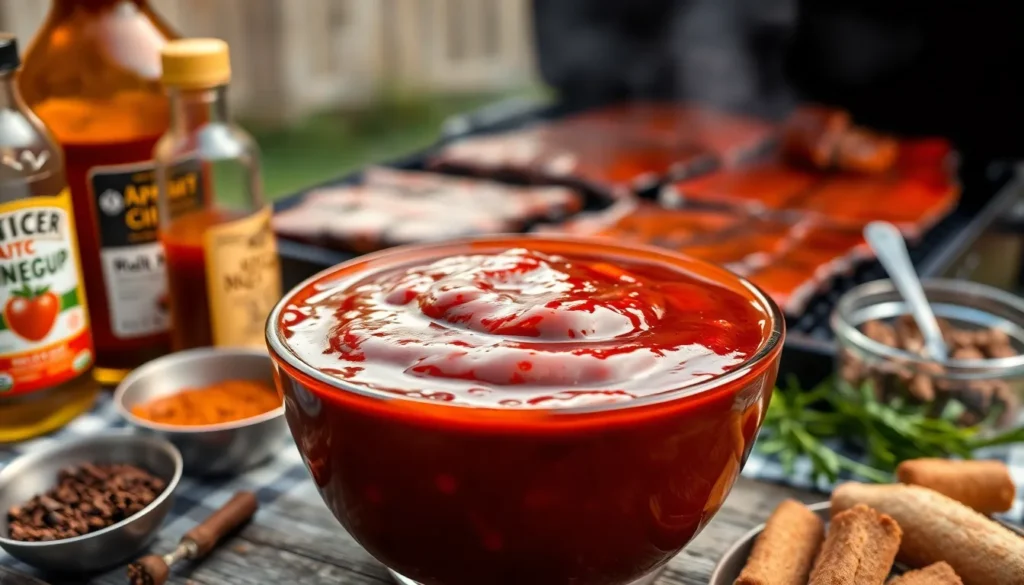Nothing transforms a simple pork dish quite like the perfect BBQ sauce. We’ve spent countless hours perfecting this recipe that strikes the ideal balance between tangy, sweet, and smoky flavors that complement pork’s natural richness.
This homemade sauce elevates everything from pulled pork sandwiches to grilled chops with its bold flavor profile. We’ve combined traditional barbecue elements with a few secret ingredients that create a sauce that’s both familiar and surprisingly complex. The beauty lies in its versatility – it works equally well as a marinade, basting sauce, or finishing glaze.
What sets our BBQ sauce apart is how it enhances rather than masks the pork’s flavor. We’ve carefully balanced brown sugar’s sweetness with apple cider vinegar’s tang and added just enough smokiness to create a sauce that’ll have your guests asking for the recipe. Ready to create barbecue magic in your own kitchen?
Ingredients
Our perfectly balanced BBQ sauce combines essential base ingredients with aromatic spices to create the ideal complement for pork. These carefully selected components work together to deliver the tangy-sweet-smoky profile that makes pork dishes exceptional.
Base Ingredients
- 1 cup ketchup
- 1/2 cup apple cider vinegar
- 1/2 cup dark brown sugar, packed
- 1/4 cup molasses
- 2 tablespoons Worcestershire sauce
- 2 tablespoons yellow mustard
- 2 tablespoons tomato paste
- 1/4 cup water
Spices and Seasonings
- 2 teaspoons smoked paprika
- 1 teaspoon garlic powder
- 1 teaspoon onion powder
- 1/2 teaspoon ground black pepper
- 1/2 teaspoon salt
- 1/4 teaspoon cayenne pepper
- 1/4 teaspoon ground cumin
- 1/4 teaspoon celery seed
Optional Add-ins for Customization
- 1 tablespoon bourbon (for deeper flavor)
- 1 teaspoon liquid smoke (for extra smokiness)
- 1-2 chipotle peppers in adobo, minced (for heat and complexity)
- 2 tablespoons honey (for additional sweetness)
- 1 tablespoon soy sauce (for umami depth)
- 1 teaspoon ground coffee (for richness)
Equipment Needed
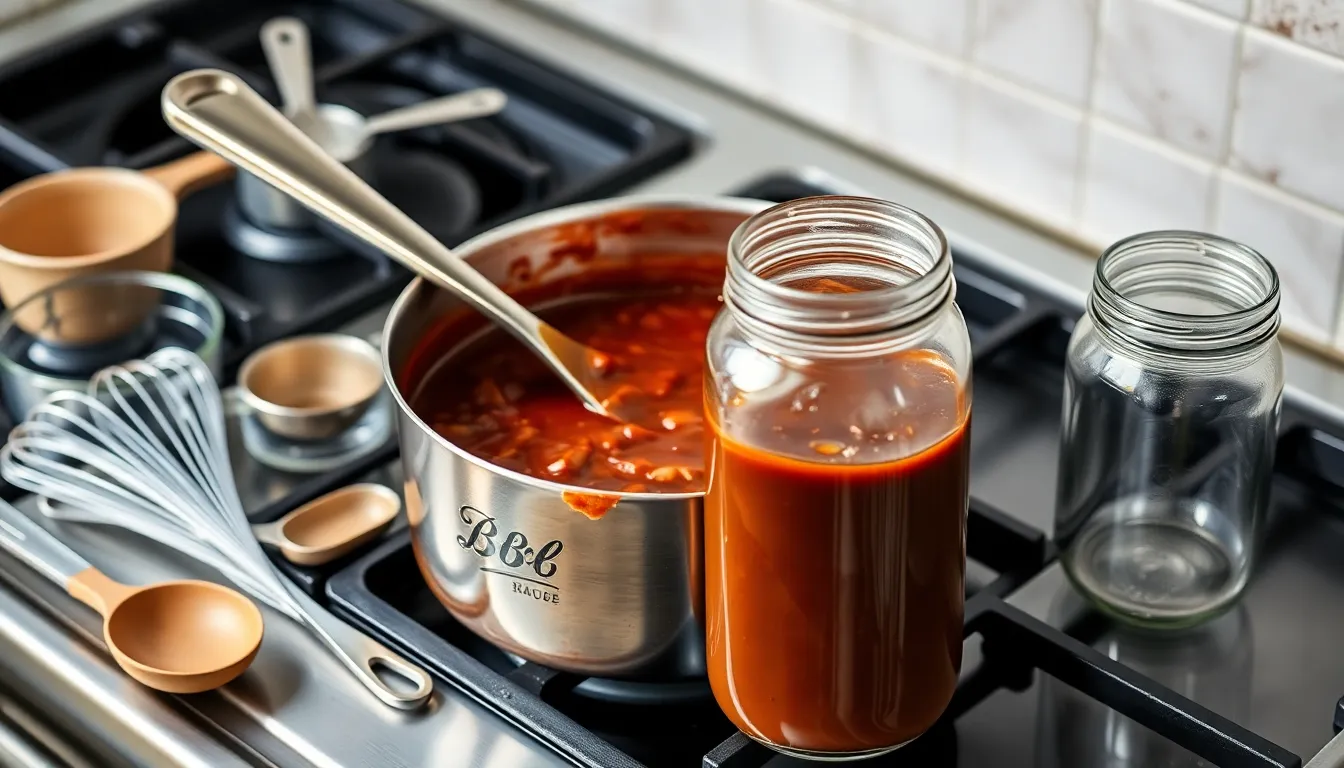
Creating our signature BBQ sauce for pork requires minimal kitchen equipment that most home cooks already have on hand. We’ll guide you through the essential tools needed to achieve the perfect consistency and flavor development.
Medium to Large Saucepan
We recommend using a medium to large saucepan with a heavy bottom to prevent scorching during the simmering process. The size ensures adequate space for the ingredients to combine properly without overflow as the sauce reduces and thickens.
Measuring Cups and Spoons
Accurate measurements are crucial for achieving the perfect balance of sweet, tangy, and smoky flavors in our BBQ sauce. We use both dry and liquid measuring tools to ensure precise ingredient ratios that complement pork’s rich flavor profile.
Whisk or Spatula for Stirring
A sturdy whisk or heat-resistant spatula becomes essential for frequent stirring during the cooking process. We prefer tools that can reach all corners of the saucepan to prevent ingredients from sticking or burning on the bottom.
Storage Container or Jar
An airtight storage container or mason jar is necessary for preserving our homemade BBQ sauce. We recommend choosing a container that holds at least 2 cups to accommodate the full recipe batch and allows for easy refrigerator storage.
These basic tools enable us to create restaurant-quality BBQ sauce that enhances any pork dish. The equipment setup takes just minutes and ensures smooth preparation from start to finish.
Instructions
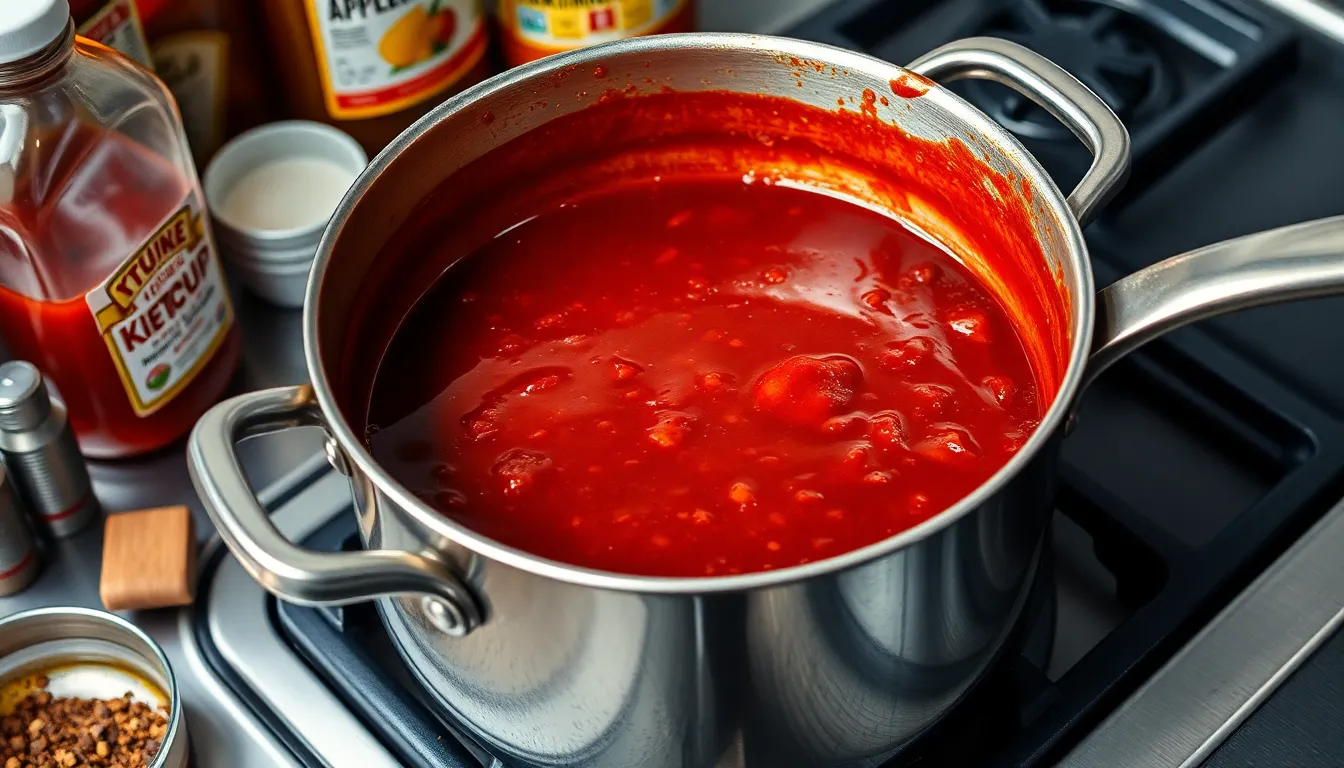
Creating this exceptional BBQ sauce requires a methodical approach that builds layers of flavor. We’ll guide you through each step to achieve the perfect balance for your pork dishes.
Prep the Base
We start by measuring out 1 cup of ketchup as our primary foundation. The ketchup provides the essential sweet and tangy backbone that makes this sauce perfect for pork. Pour the ketchup into a medium mixing bowl and set aside while we prepare the remaining wet ingredients.
Combine Wet Ingredients
Add the apple cider vinegar to the ketchup, measuring out ½ cup for optimal acidity that will tenderize the pork. We incorporate ⅓ cup of dark brown sugar next, whisking thoroughly to dissolve any lumps. Pour in ¼ cup of molasses for deep sweetness and 1 tablespoon of Worcestershire sauce for umami depth. Blend these wet ingredients completely until the mixture appears smooth and uniform.
Add Spices and Seasonings
Whisk in ¼ teaspoon each of garlic powder and onion powder for aromatic foundation. We add ½ teaspoon of smoked paprika to infuse that essential smoky character. Incorporate ¼ teaspoon of black pepper and a pinch of cayenne pepper for subtle heat. Add ⅛ teaspoon each of ground mustard and cinnamon for complexity, then season with ½ teaspoon of salt. Finally, stir in 2 teaspoons of liquid smoke for authentic barbecue flavor.
Simmer and Reduce
Transfer the complete mixture to a medium saucepan and place over medium heat. Bring the sauce to a gentle boil, then immediately reduce heat to low. We simmer the sauce for 15 to 20 minutes, stirring occasionally to prevent sticking. The sauce will thicken slightly and the flavors will meld beautifully during this process.
Adjust Seasoning to Taste
Remove the saucepan from heat and taste the cooled sauce carefully. We recommend adjusting sweetness with additional brown sugar if needed, or adding more vinegar for extra tang. Increase the cayenne pepper gradually if you prefer more heat. Let the sauce cool completely before transferring to an airtight container for storage.
Different BBQ Sauce Styles for Pork
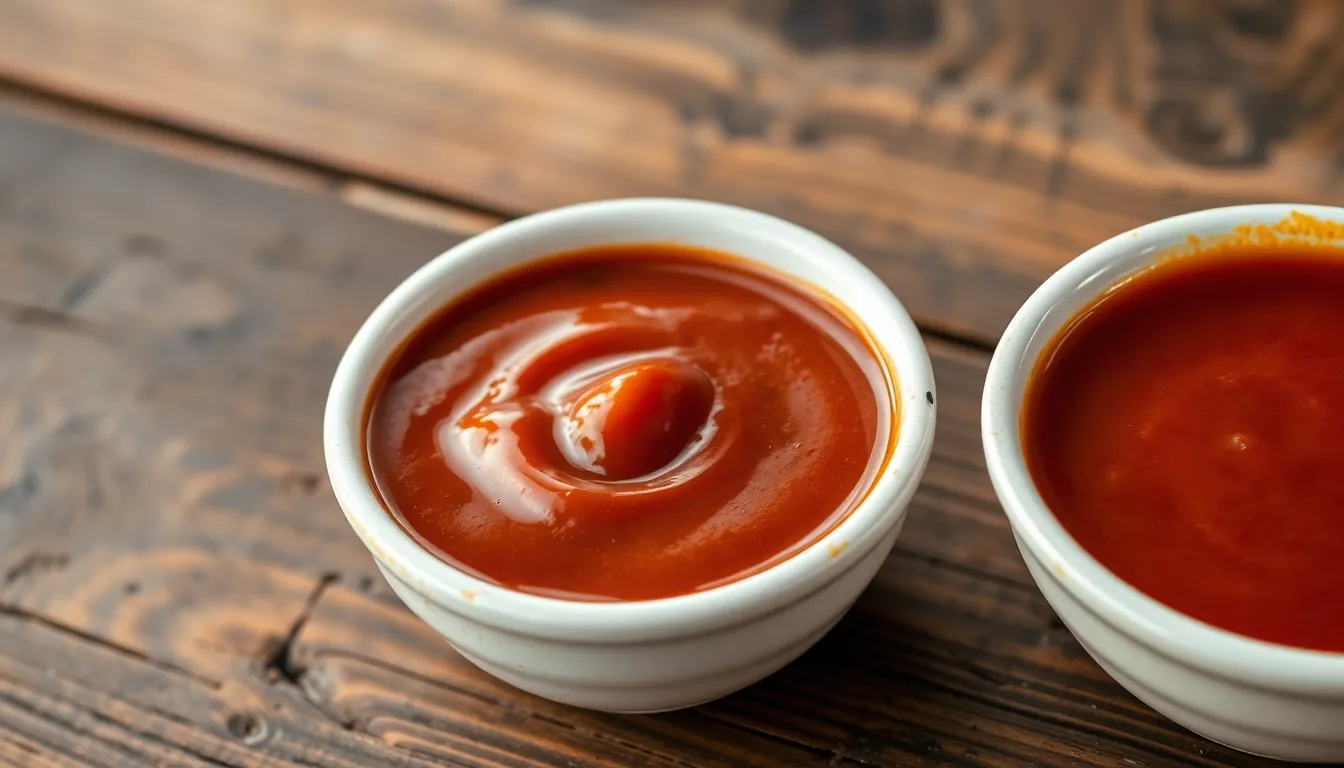
Regional barbecue traditions across America have created distinct sauce styles that perfectly complement pork dishes. Each style offers unique flavor profiles that reflect their local heritage and cooking methods.
Kansas City Style Sweet and Thick
Kansas City style BBQ sauce delivers a rich, sweet experience with its signature tomato base enhanced by brown sugar and molasses. We find this thick, syrupy consistency clings beautifully to pork ribs and burnt ends, creating a glossy coating that caramelizes during cooking. The sweetness from brown sugar balances perfectly with smoky and savory elements, while chili powder and cayenne add subtle heat to create flavor complexity.
| Characteristic | Details |
|---|---|
| Base | Thick tomato base |
| Primary Sweeteners | Brown sugar and molasses |
| Texture | Syrupy consistency |
| Best Pork Applications | Ribs and burnt ends |
| Heat Level | Mild spiciness from chili powder and cayenne |
This versatile sauce works across various meat preparations and provides the sweet richness that makes Kansas City barbecue famous throughout the country.
Carolina Style Tangy and Vinegar-Based
Carolina style sauces showcase vinegar as their foundation, delivering sharp tanginess with minimal sweetness that enhances pork’s natural flavors without overpowering them. We appreciate how this thin consistency works perfectly as a mop sauce during cooking or as a finishing drizzle for pulled pork. Eastern North Carolina particularly champions this style for its ability to cut through rich pork fat while adding bright acidity.
South Carolina offers a mustard variant that brings bright, tangy sweetness reflecting the region’s German heritage. This golden sauce adds complexity while maintaining the characteristic Carolina emphasis on improving rather than masking the meat.
| Style Variant | Base | Flavor Profile | Regional Origin |
|---|---|---|---|
| Eastern Carolina | Vinegar | Sharp, tangy, minimal sweetness | Eastern North Carolina |
| South Carolina Mustard | Mustard and vinegar | Bright, tangy, slightly sweet | South Carolina |
Memphis Style Dry Rub Alternative
Memphis style barbecue offers a balanced approach between tomato and vinegar with moderate sweetness that creates smoky, slightly spicy flavor profiles. We recognize Memphis for pioneering the dry rub technique, heavily featuring paprika and complementary spices as an alternative to heavy sauce application. This method allows the meat’s natural flavors to shine while building a flavorful crust.
When Memphis barbecue is served “wet,” the sauce remains lighter than Kansas City style, complementing rather than masking the pork’s taste. The thinner consistency compared to Kansas City sauce creates a perfect balance that supports the meat without overwhelming it.
| Preparation Method | Characteristics | Application |
|---|---|---|
| Dry Rub | Paprika-heavy spice blend | Creates flavorful crust without sauce |
| Wet Style | Lighter sauce application | Complements meat without overpowering |
Application Methods
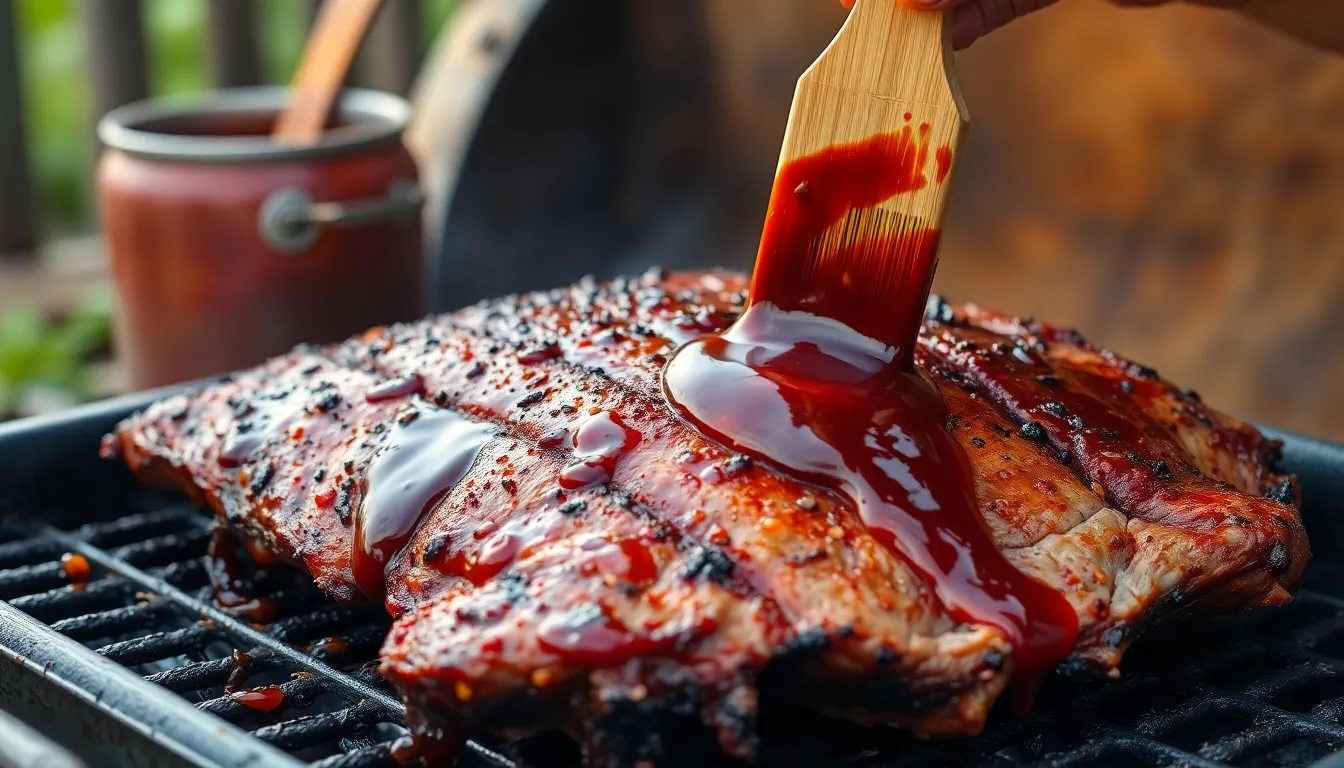
Once you’ve crafted the perfect BBQ sauce, understanding how to apply it properly makes all the difference in your pork dishes. We’ll explore three proven techniques that maximize flavor while ensuring your pork stays tender and delicious.
Basting During Cooking
Basting pork with BBQ sauce during the cooking process adds layers of flavor while keeping the meat moist throughout. We recommend applying the sauce periodically during slow cooking to create a rich glaze that penetrates the meat. The key timing involves brushing the sauce during the final 20-30 minutes of cooking to prevent burning the sugars in your BBQ sauce.
For pork shoulder, we suggest slow cooking the meat first, then transferring it to the oven for the final stage. Basting with reserved cooking fat and your BBQ sauce for 15-20 minutes develops a beautiful caramelized crust. This technique works exceptionally well for larger cuts that benefit from extended cooking times.
| Application Method | Timing | Cooking Time | Result |
|---|---|---|---|
| Basting During Cooking | Final 20-30 minutes | 15-20 minutes in oven | Caramelized glaze |
| Finishing Sauce | After cooking complete | Just before serving | Enhanced moisture |
| Marinade Option | Before cooking starts | 2-24 hours | Deep flavor infusion |
Finishing Sauce
Using BBQ sauce as a finishing sauce allows the sauce’s full flavor profile to shine without heat diminishing its complexity. We apply this method after the pork is completely cooked and shredded or sliced. Pulled pork benefits tremendously from being tossed with finishing sauce just before serving, ensuring even coating and added moisture.
Homemade southern BBQ sauces work particularly well as finishing sauces because their concentrated flavors complement the rich pork without overwhelming it. We often simmer and thicken our BBQ sauce before using it as a finishing sauce to achieve the perfect consistency that clings to the meat.
Marinade Option
BBQ sauce serves as an excellent marinade base, infusing pork with flavor before cooking begins. We balance this approach by combining a dry rub with a small amount of BBQ sauce or vinegar based sauce to avoid texture issues from prolonged acid exposure. The marinade process allows pork to absorb flavors gradually during slow cooking.
Our preferred technique involves applying a BBQ rub first, then cooking the pork with complementary liquids like beer, soy sauce, or apple cider vinegar. Adding BBQ sauce during the final stages creates layers of flavor that penetrate throughout the meat. This method works exceptionally well for pulled pork, pork chops, and tenderloin preparations where deep flavor infusion enhances the final dish.
Storage Instructions

Proper storage extends the life of our homemade BBQ sauce and maintains its vibrant flavor profile. Following these guidelines ensures we can enjoy our sauce for weeks or even months after making it.
Refrigerator Storage
We recommend storing our homemade BBQ sauce in an airtight container like a Mason jar immediately after it cools to room temperature. The sauce maintains its peak quality in the refrigerator for up to 2 weeks when stored at 40°F or below.
Always use clean utensils when removing sauce from the container to prevent contamination. Store the container toward the back of the refrigerator where temperatures remain most consistent. Before each use, we suggest giving the sauce a quick stir as natural separation may occur during storage.
Freezing Options
For extended storage, we can freeze our BBQ sauce in airtight containers or freezer-safe bags for 3 to 6 months. Portion the sauce into smaller containers before freezing to make thawing more convenient for future use.
When ready to use frozen sauce, transfer it to the refrigerator and allow it to thaw overnight. Stir the thawed sauce thoroughly as separation commonly occurs during the freezing process. Never refreeze previously frozen BBQ sauce as this affects both texture and flavor quality.
Make-Ahead Tips
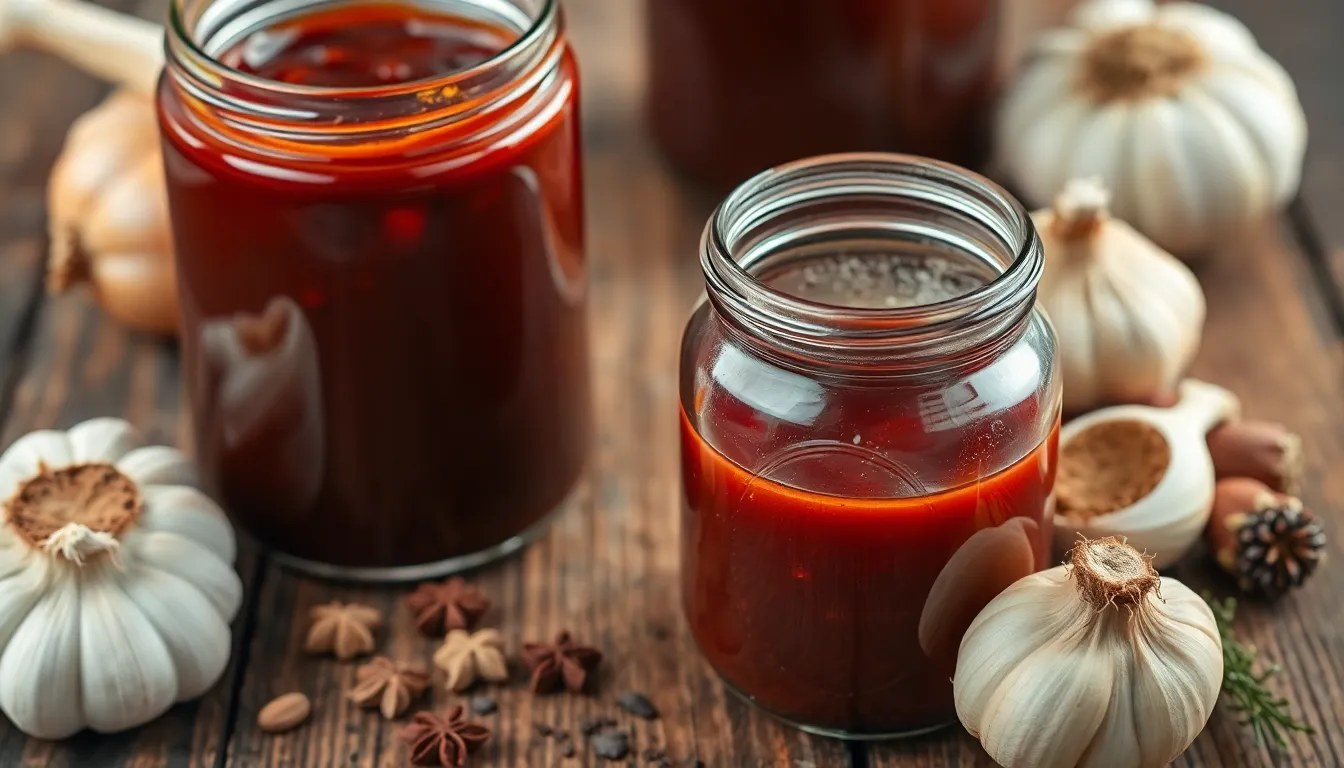
BBQ sauce flavors improve dramatically when we prepare them ahead of time because the ingredients marry and develop deeper complexity over several days. We can make our pork BBQ sauce up to 2 weeks in advance and store it in the refrigerator in airtight containers where it will continue to enhance in flavor.
Planning ahead saves us valuable time on cooking day and allows us to focus on preparing the pork rather than juggling multiple components. We recommend making the sauce at least 24 hours before we plan to use it to allow the flavors to meld properly.
| Make-Ahead Timeline | Storage Duration | Flavor Development |
|---|---|---|
| 24 hours ahead | Optimal minimum | Initial flavor melding |
| 1 week ahead | Excellent | Full flavor integration |
| 2 weeks ahead | Maximum recommended | Peak flavor complexity |
Some BBQ sauces remain good when refrigerated for up to 3 weeks depending on their acidity levels and ingredients. We should always store our sauce in clean airtight containers to prevent contamination and maintain freshness.
The make-ahead approach works particularly well for pulled pork preparation since we can cook the pork shoulder in advance as well. We can shred the cooked pork and refrigerate or freeze it separately then combine it with our pre-made BBQ sauce when reheating for serving.
We can also customize our sauce after the initial preparation period by tasting and adjusting sweetness or heat levels before serving. This flexibility allows us to perfect the flavor balance based on our exact pork dish or guest preferences.
For meal prep enthusiasts we recommend portioning the sauce into smaller containers so we can use only what we need while keeping the remaining sauce fresh for future cooking sessions.
Serving Suggestions
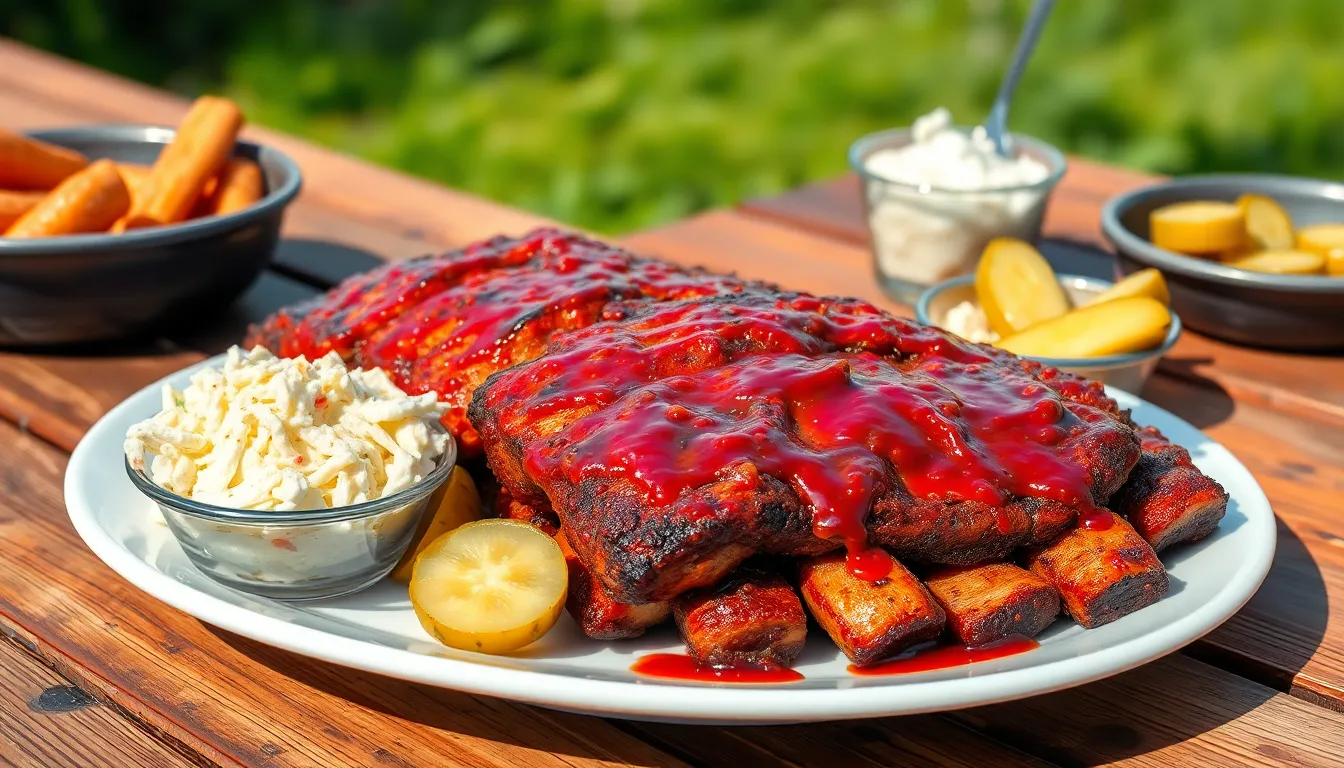
Our perfected BBQ sauce transforms ordinary pork dishes into extraordinary culinary experiences. The right cut of pork and complementary sides create a harmonious meal that showcases the sauce’s complex flavors.
Best Pork Cuts to Pair With
Pork shoulder stands as our top recommendation for BBQ sauce applications. This cut contains high fat content and connective tissue that breaks down during slow cooking, creating tender meat that absorbs our sauce’s flavors beautifully. We find that Boston butt, a exact cut from the pork shoulder, works exceptionally well for pulled pork preparations.
Spare rib chops offer another excellent pairing option. These cuts feature thin layers of fat that maintain moisture throughout the cooking process, making them ideal candidates for BBQ sauce glazing. The natural tenderness and flavor of spare rib chops complement our sauce without competing with its taste profile.
Pork belly slices provide rich, succulent meat that pairs perfectly with BBQ sauce. Their high fat content keeps the meat moist during grilling or roasting, while the sauce adds layers of sweet and tangy flavors that balance the richness.
Pork ribs remain classic BBQ favorites that showcase our sauce exceptionally well. Both spare ribs and baby back ribs contain enough fat and connective tissue to hold up during extended cooking times while absorbing the sauce’s complex flavors.
We recommend avoiding lean cuts like pork loin when using BBQ sauce for smoking or grilling. These cuts tend to dry out quickly and don’t retain moisture effectively with BBQ sauces.
Side Dish Recommendations
Coleslaw serves as our primary side dish recommendation for BBQ pork. Its refreshing crunch and natural acidity provide perfect balance against the rich, sauce-coated meat. We prefer creamy coleslaw for pulled pork sandwiches and vinegar-based versions for grilled cuts.
Baked beans complement BBQ pork through their sweet flavor profile and hearty texture. These beans echo the sweetness in our sauce while adding protein and fiber to round out the meal.
Cornbread offers mild sweetness and crumbly texture that contrasts beautifully with saucy pork. We recommend serving warm cornbread or corn muffins to soak up extra sauce from the plate.
Grilled vegetables add color and nutrition to BBQ pork meals. Corn on the cob, asparagus, and bell peppers work particularly well because their natural sweetness harmonizes with our sauce’s flavor profile.
Potato salad provides creamy, hearty accompaniment that satisfies appetites alongside BBQ pork. This traditional side dish offers neutral flavors that allow our sauce to shine while adding substance to the meal.
Pickles and pickled vegetables cut through the richness of sauce-glazed pork with their sharp acidity. We recommend serving dill pickles, pickled jalapeños, or pickled onions to cleanse the palate between bites.
Conclusion
We’ve equipped you with everything needed to master BBQ sauce for pork. From understanding regional styles to perfecting application techniques our comprehensive guide ensures your next barbecue will be memorable.
The beauty of homemade BBQ sauce lies in its versatility and potential for customization. Whether you prefer Kansas City’s sweet richness Carolina’s tangy bite or Memphis’s balanced approach you now have the knowledge to create your signature blend.
Remember that great BBQ sauce isn’t just about the recipe—it’s about timing storage and pairing with the right cuts. Let your sauce rest overnight for maximum flavor development and don’t be afraid to experiment with different combinations until you find your perfect match.
Your pork dishes will never be the same once you start crafting your own BBQ sauce. Fire up that grill and let your culinary creativity shine.
Frequently Asked Questions
What are the main ingredients in homemade BBQ sauce for pork?
The essential ingredients include ketchup as the tomato base, apple cider vinegar for tanginess, and dark brown sugar for sweetness. Key spices are smoked paprika and garlic powder. Optional add-ins like bourbon can add deeper flavor, while chipotle peppers provide heat. These ingredients create the perfect balance of tangy, sweet, and smoky flavors that complement pork dishes.
How long can I store homemade BBQ sauce?
Homemade BBQ sauce can be stored in an airtight container in the refrigerator for up to 2 weeks. For longer storage, freeze it in airtight containers or freezer-safe bags for 3 to 6 months. Always use clean utensils to prevent contamination, and avoid refreezing thawed sauce to maintain quality and texture.
What’s the difference between Kansas City, Carolina, and Memphis BBQ sauce styles?
Kansas City style is thick and sweet with a tomato base that clings to meat. Carolina style features vinegar for a tangy, sharp flavor profile. Memphis style balances tomato and vinegar elements while focusing on dry rub techniques. Each regional style offers unique flavor characteristics that enhance pork dishes differently.
When should I apply BBQ sauce to pork during cooking?
Apply BBQ sauce during the final 20-30 minutes of cooking for basting, which creates a rich glaze. You can also use it as a finishing sauce just before serving to enhance moisture and flavor. For deeper flavor infusion, marinate pork in the sauce before cooking, combining it with dry rubs for optimal results.
What cuts of pork work best with BBQ sauce?
The best cuts include pork shoulder, spare ribs, pork belly, and pork ribs – all fatty cuts that complement the sauce’s rich flavors. Avoid lean cuts like pork loin, as they don’t pair as well with BBQ sauce. These fattier cuts become more tender and flavorful when combined with the sauce’s tangy-sweet profile.
Should I make BBQ sauce ahead of time?
Yes, making BBQ sauce ahead of time significantly improves the flavor as ingredients meld together. Allow at least 24 hours for optimal flavor development, and you can prepare it up to 2 weeks in advance for peak complexity. This make-ahead approach is especially useful for meal prep and pulled pork preparations.
What side dishes pair well with BBQ pork?
Complementary sides include coleslaw for crunch and freshness, baked beans for hearty sweetness, and cornbread for texture contrast. Grilled vegetables, potato salad, and pickles also enhance the dining experience by balancing the rich, smoky flavors of the BBQ sauce and creating a well-rounded meal.
What kitchen equipment do I need to make BBQ sauce?
You’ll need a medium to large saucepan for cooking, accurate measuring cups and spoons for ingredients, and a whisk or wooden spoon for mixing. An airtight storage container is essential for preserving the sauce. These basic tools are sufficient to create restaurant-quality BBQ sauce at home.

